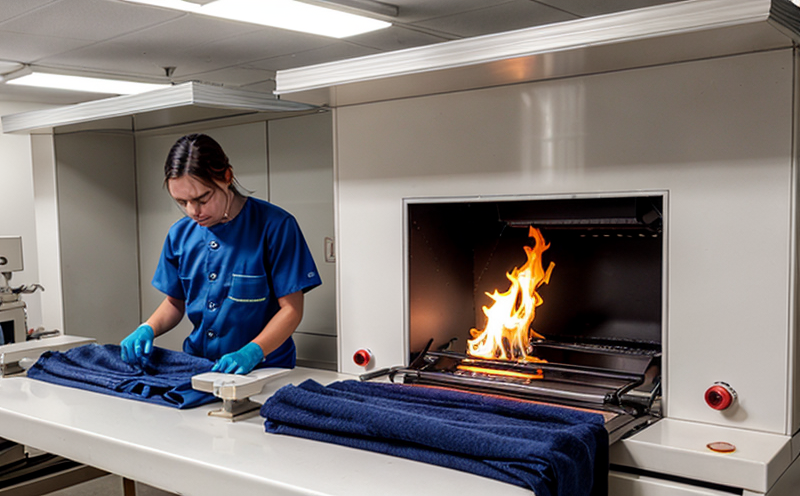Fire Performance Testing of Industrial Protective Pants
In industries where workers are exposed to potential fire hazards, ensuring the safety and protection of personnel is paramount. The fire performance testing of industrial protective pants is a critical aspect of this safety protocol. This service involves assessing how well these garments withstand exposure to flames or other forms of thermal stress. By adhering to international standards such as ISO 11611:2019, the testing ensures that workers are equipped with garments that can provide adequate protection against fire-related incidents.
Fire performance tests on industrial protective pants typically include several key elements:
- Flame Resistance: This test evaluates how quickly a flame can ignite the fabric and determine its self-extinguishing properties. The standard test method for this is ISO 11611:2019, which specifies that the pants should have a burn time of less than 3 seconds.
- Thermal Protective Performance (TPP): This measures the thermal protection provided by the fabric against heat. TPP values indicate how effective the garment is at protecting the wearer from burns when exposed to fire or other high-temperature sources.
- Smoke and Heat Release: This test assesses the amount of smoke and heat that a material can release under flame exposure, which is crucial for understanding the environmental impact in case of a fire incident.
The testing process involves rigorous specimen preparation. The fabric samples are cut to specific dimensions as per ISO standards and then subjected to controlled conditions within a calorimeter or other equivalent equipment. The results are analyzed based on criteria outlined by relevant international standards, ensuring compliance with industry regulations.
Industrial protective pants designed for fire performance testing must meet stringent requirements that vary depending upon the intended use of the garment. These include protection against flames, sparks, and molten metal splashes. The testing process is not only about meeting these regulatory requirements but also about providing real-world reliability under expected conditions.
For instance, in industries like mining or construction where workers are frequently exposed to fire hazards, industrial protective pants must be able to withstand prolonged exposure without compromising the safety of the wearer. The testing process ensures that these garments are not only compliant with international standards but also dependable and effective under actual working conditions.
Understanding the importance of fire performance testing is crucial for quality managers, compliance officers, R&D engineers, and procurement professionals involved in selecting appropriate protective clothing. By investing in high-quality fire-tested industrial protective pants, these professionals can ensure that their workforce is adequately protected against potential hazards, thereby enhancing overall safety standards.
Industry Applications
The application of fire performance testing on industrial protective pants extends across various sectors where workers are exposed to high-risk environments. Industries such as mining, construction, manufacturing, and petrochemicals rely heavily on these garments for their workforce's safety.
In the mining sector, firefighters often wear specialized protective clothing designed to withstand intense heat from fires or explosions. The fire performance testing ensures that these garments can protect miners even in highly combustible environments. Similarly, construction workers who are involved in demolition tasks where sparks and molten metal splashes are common risks benefit greatly from such protective gear.
Manufacturing plants dealing with volatile chemicals may also require industrial protective pants to be flame-resistant to prevent accidents caused by unexpected fires or explosions. Petrochemical facilities face unique challenges due to the presence of flammable substances, making fire performance testing an essential component in selecting appropriate personal protective equipment (PPE).
These applications highlight why fire performance testing is not merely a compliance exercise but a critical aspect of ensuring worker safety and reducing the risk of injury or death. By investing in high-quality garments that have passed rigorous fire tests, industries can significantly enhance their safety protocols.
International Acceptance and Recognition
The international acceptance and recognition of fire performance testing for industrial protective pants are rooted in the need to ensure consistent quality and reliability across borders. The global nature of industries like manufacturing, construction, and mining means that workers often travel between countries, necessitating uniform standards.
International organizations such as ISO (International Organization for Standardization) play a crucial role in setting these standards. For example, the ISO 11611:2019 standard provides a framework for testing fire-resistant protective clothing, ensuring that it meets specific performance criteria regardless of where it is manufactured or used.
| Standard | Description |
|---|---|
| ISO 11611:2019 | This standard specifies the performance requirements and test methods for protective clothing intended to provide protection against flame, flash fire and molten metal splashes. |
| ASTM F1506-18 | Similar to ISO 11611:2019, this standard sets performance criteria for flame-resistant protective clothing used in various industrial sectors. |
| EN 467:2005 | This European standard focuses on the protection against molten metal splashes and is widely recognized in Europe. |
The acceptance of these standards by countries around the world ensures that industrial protective pants meet the same safety benchmarks, regardless of their origin. This global recognition enhances trust among buyers and end-users, ensuring that they have reliable products that can be used confidently across different regions.





